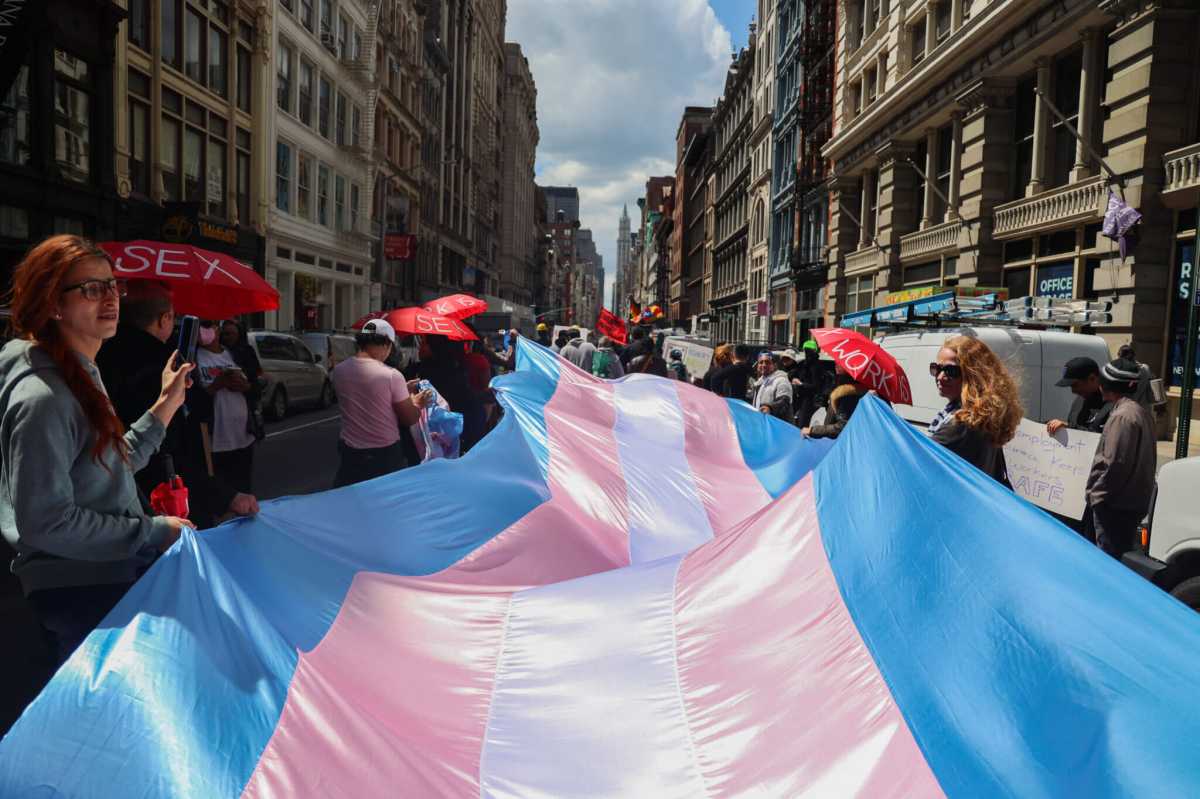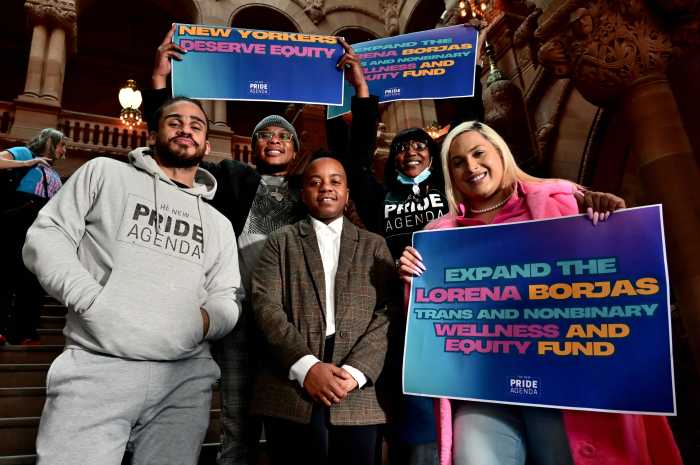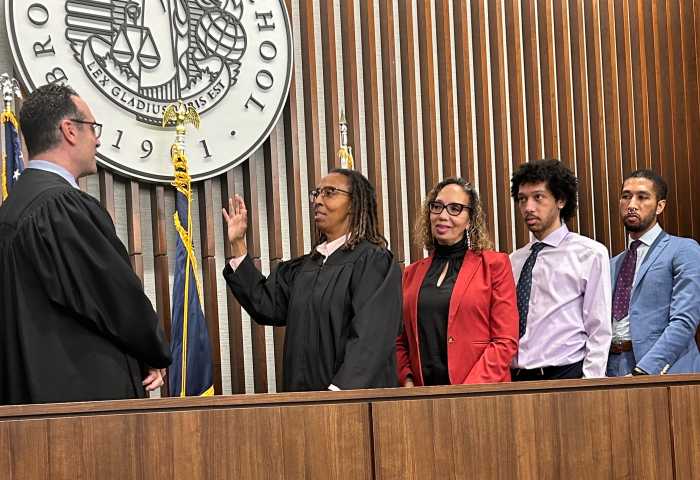Transgender, gender non-conforming, and non-binary (TGNCNB) New Yorkers experience greater rates of discrimination and harassment in the hiring process and in the workplace, according to a new and comprehensive report on the state of employment for TGNCNB people in New York State.
The report, which was published by the New York State Department of Labor and encompasses employment statistics and qualitative feedback, represented the culmination of a long-stalled initiative: State lawmakers ordered the state to conduct the study as part of legislation that passed in 2022 after it was previously blocked for years when the upper chamber was controlled by Republicans.
The report combined a range of data sources to gather information, including the Census Bureau’s Household Pulse Survey, the Center for Disease Control and Prevention’s Behavioral Risk Factor Surveillance System (BRFSS), and state surveys distributed by the New York LGBT Health and Human Services Network. However, the report stressed that statistics were inconsistently weighted, with research often featuring far more cisgender respondents than trans respondents.
The data in the report indicated troubling realities in the workplace. TGNCNB respondents reported that they experienced harassment in the context of violence, sexual harassment, invasive questions, jokes, inappropriate touching, and other hostile actions. TGNCNB workers in public-facing roles — such as in the service industry — also faced harassment on the job. Overall, many people also expressed that their employers failed to address the issues.
The report further examined the overall state of discrimination targeting TGNCNB individuals. For example, through the month of October in 2023, the state’s Division of Human Rights had fielded more than 1,200 complaints regarding gender identity or expression, 65% of which were related to employment discrimination and 26% pertaining to discrimination in public accommodations.
The BRFSS survey found that 56% of cisgender people in the state were employed or self-employed compared to 49% of trans people. Meanwhile, the same survey also revealed that 15% of trans people were unemployed, while cisgender people reported 7% unemployment.
Among many other points, the report also shed light on the general economic woes facing trans New Yorkers. About 32% of trans New Yorkers report a household income under $25,000 as opposed to just 13% of cisgender individuals, according to numbers pulled from the Center for Disease Control and Prevention’s Behavioral Risk Factor Surveillance System. On the flip side, there are twice as many cisgender individuals with incomes over $50,000: Around 20% of trans people have a household income of at least $50,000 compared to 42% of cisgender people with incomes at or above $50,000.
The results of the 2021 LGBT Health and Human Services Network’s Needs Assessment Survey demonstrated how TGNCNB New Yorkers face marginalization in comparison to cisgender queer people. While 21% of trans men, 14% of trans women, and 21% of GNCNB people were unemployed at the time of their survey response, that number dropped to just 6% for cis queer women and 9% for cis queer men.
When evaluating education, one-third of trans New Yorkers never graduated high school — far more than the 12% of cisgender New Yorkers who did not finish high school. Just 20% of trans New Yorkers have a college degree, but that number jumps to 36% for cis New Yorkers.
Furthermore, statistics show TGNCNB individuals have experienced hurdles in the effort to align their legal identification with their gender identity. In the 2021 Network Needs Assessment survey, 33% of TGNCNB respondents wanted to change their gender marker on their birth certificate, but just 19% had done so.
In addition to the quantitative data, the report also incorporated qualitative responses to learn more about individual experiences. Those responses also allowed TGNCNB people of color to elaborate on troubling experiences when looking for a job or in the workplace. An online public form yielded comments describing combinations of racial discrimination and discrimination on the basis of gender identity or expression. That kind of hostile atmosphere, the report said, prevents individuals from speaking up.
One Black and Latinx trans woman who submitted a comment stated that some colleagues see her as a threat to their positions, while a white non-binary individual expressed that going to HR “is no comfort, since several members have not only been transphobic but also indulging in openly racist jokes” and “several anti-semitic comments.”
One two-spirit individual who identifies as American Indian/Alaskan Native said when they started their transition, their family threw them out of the house — and they’ve only been able to acquire internship positions.
The report issued a series of recommendations for improvements moving forward, including calling for uniform data collection on gender identity, workforce development programs for TGNCNB communities, cultural competency and GENDA training across New York, easier access to legal ID updates, and employment resources for people who have been involved in the justice system. Moreover, the report suggested expanding the Lorena Borjas Transgender Wellness and Equity Fund, which steers resources to organizations serving transgender individuals in the state.
New Pride Agenda, a statewide LGBTQ organization that helped spearhead the push for the Lorena Borjas fund, welcomed calls to expand it.
“We know that trans-led and serving organizations are best equipped to provide the necessary workforce development training to ensure TGNCNB people have access to gainful employment,” Elisa Crespo, New Pride Agenda’s executive director, said in a written statement.
Crespo said the report confirms the pervasive nature of employment discrimination on the basis of gender identity and the exacerbated disparities facing TGNCNB people of color. Crespo stressed the importance of training employers and providing more job opportunities for TGNCNB people. Still, she said, New York is in a much better position than some other states at a time when anti-trans laws have flooded other state governments.
“Despite the employment challenges faced by TGNCNB New Yorkers, we continue to believe that New York provides more opportunities for TGNCNB people than the majority of states in the country,” Crespo said. “As the state with the second highest TGNCNB youth population, NPA looks forward to working with the Governor, lawmakers, organizational partners, and the NYS DOL, to ensure that the next generation of TGNCNB New Yorkers are able to live and thrive — not just survive.”
Kiara St. James, who co-founded New York Transgender Advocacy Group and pushed for the legislation that led to the report, issued a letter accompanying the report pointing to the importance of collecting data on the TGNCNB community in order to advocate for healthcare, housing, employment, and other areas.
“Collecting data leads to identifying the needs and priorities of marginalized communities,” St. James said in the note.
After the report was released, Governor Kathy Hochul vowed to utilize the data to address inequities prevalent in the state.
“As the birthplace of the LGBTQ+ civil rights movement, New York State has maintained a deep commitment to providing greater respect, stronger protections, and better opportunities for the LGBTQ+ community,” Governor Hochul said. “This report provides a glimpse into the work lives of trans, gender non-confirming, and non-binary New Yorkers and charts a path forward on addressing the barriers they face. New York remains committed to providing an open and affirming workplace for all workers, and my administration will continue to provide the resources and protections needed for every New Yorker to live free from discrimination.”
































